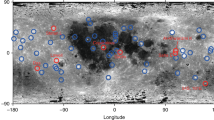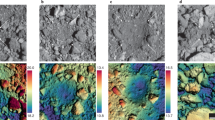Abstract
Since 1969 ∼5,000 meteorite fragments have been recovered from two regions, the Yamato Mountains and Victorialand, on opposite sides of the East Antarctic ice cap1,2. Based on a steady-state model for the ice cap3, and current estimates of meteorite influx4, a model is developed here which predicts that the steady-state number of meteorites being carried in and on the ice is at least 760,000. Most of these are being carried within the ice and are only exposed at peripheral regions by a combination of wind ablation and blockage of ice movement by protruding mountain barriers. The large steady-state population of meteorites does not require unusual conditions of influx. It is solely the cold, dry climate which preserves virtually all meteorites that fall except for the fragile, porous carbonaceous chondrites. The same model applied to the Greenland ice cap indicates a steady-state population of ∼61,000 meteorites.
This is a preview of subscription content, access via your institution
Access options
Subscribe to this journal
Receive 51 print issues and online access
$199.00 per year
only $3.90 per issue
Buy this article
- Purchase on Springer Link
- Instant access to full article PDF
Prices may be subject to local taxes which are calculated during checkout
Similar content being viewed by others
References
Cassidy, W. A., Olsen, E. & Yanai, K. Science 198, 727–731 (1977).
Nagata, T. Proc. 2nd Symp. Yamato Meteorites 70–92 (1978).
Nagata, T. Antarctic Rec. No. 60, 13–27 (1977).
Hughes, D. W. in Solid Particles in the Solar System (eds Halliday, I. & McIntosh, B. A.) 207–210 (International Astrophysical Union, 1980).
Paterson, W. S. B. in Dynamics of Snow and Ice Masses (ed. Colbeck, S.C.) 1–78 (Academic, New York, 1980).
Gow, A. J. in Antarctica (ed. Hatherton, T.) 221–258 (Methuen, London, 1965).
Yanai, K. Catalog of Yamato Meteorites, 1–188 (National Institute of Polar Research, Tokyo, 1979).
Score, R. et al. Antarctic Met. Newslett. 4, 1–144 (1981).
King, T. V. V., Score, R., Gabel, E. M. & Mason, B. Smithsonian Contr. Earth Sci. No. 23, 12–44 (1980).
Hellyer, B. Earth planet. Sci. Lett. 7, 148–150 (1969).
Hughes, D. W. Meteoritics (submitted).
Brown, H. J. geophys. Res. 66, 1316–17 (1961).
Halliday, I. Meteoritics 2, 271–278 (1964).
ReVelle, D. O. Nat. Res. Council Canada, Planet. Sci. SR-76-1 (1976).
Shackleton, J. J. & Kennett, J. P. Init. Rep. DSDP Leg 29 (1965).
Raymond, C. F. in Dynamics of Snow and Ice Masses (ed. Colbeck, S. C.) 80–114 (Academic, New York, 1980).
Proc. int. glaciol. Soc. (1979).
Yanai, K. Mem. Nat. Inst. Polar Res. Spec. Iss. 8, 1–37 (1978).
Cassidy, W. A. Smithsonian Contr. Earth Sci. No. 23, 3–7 (1980).
Evans, J. C. & Rancitelli, L. A. Smithsonian Contr. Earth Sci. No. 23, 45–46 (1980).
Author information
Authors and Affiliations
Rights and permissions
About this article
Cite this article
Olsen, E. Estimates of total quantity of meteorites in the East Antarctic ice cap. Nature 292, 516–518 (1981). https://doi.org/10.1038/292516a0
Received:
Accepted:
Issue Date:
DOI: https://doi.org/10.1038/292516a0
This article is cited by
-
Antarktische Meteorite
Naturwissenschaften (1982)
-
Meteoritics — more facts, more complexity
Nature (1981)
Comments
By submitting a comment you agree to abide by our Terms and Community Guidelines. If you find something abusive or that does not comply with our terms or guidelines please flag it as inappropriate.



